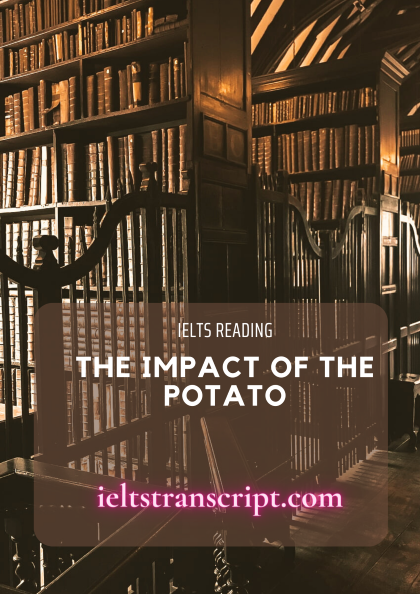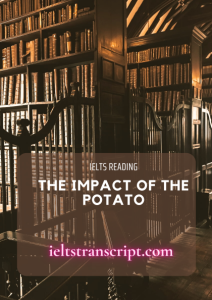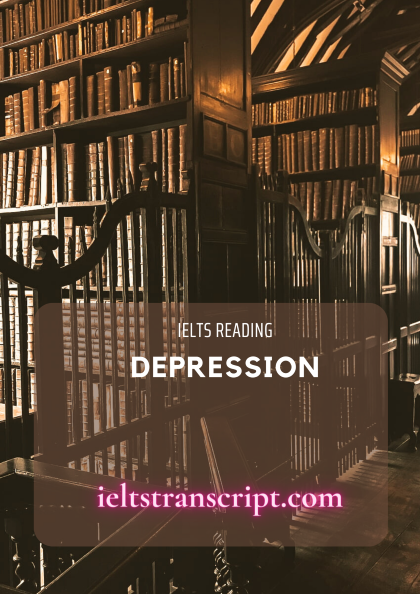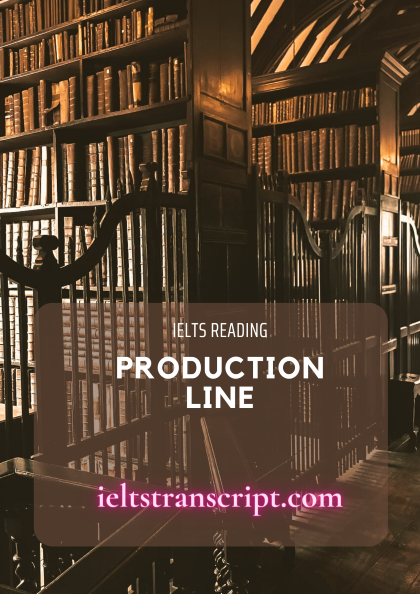- Đối với sản phẩm có giá: Sau khi chúng tôi ghi nhận thông tin đã thanh toán sản phẩm của bạn, sản phẩm sẽ được mở khóa và bạn có thể xem trực tiếp và tải tài liệu sản phẩm.
- Đối với thành viên trả phí: Bạn có thể mua và thanh toán sản phẩm với giá 0đ để tải tài liệu sản phẩm.
- Bạn có thể liên hệ với chúng tôi để được hỗ trợ mở khóa sản phẩm sớm nhất.
THE IMPACT OF THE POTATO
- Chúng tôi chấp nhận các phương thức thanh toán sau đây: Thẻ tín dụng, thẻ ghi nợ, PayPal, chuyển khoản ngân hàng và tiền mặt.
Chúng tôi sẽ không thu thêm phí cho bất kỳ hình thức thanh toán nào.
- Nếu bạn gặp vấn đề về sản phẩm của chúng tôi trong thời gian sử dụng, vui lòng liên hệ với chúng tôi để được hỗ trợ xử lý sớm nhất nhé.
Xem trước mẫu
The Impact of the Potato
Jeff Chapman relates the story of history the most important vegetable
A.The potato was first cultivated in South America between three and seven thousand years ago, though scientists believe they may have grown wild in the region as long as 13,000 years ago. The genetic patterns of potato distribution indicate that the potato probably originated in the mountainous west-central region of the continent.
B.Early Spanish chroniclers who misused the Indian word batata (sweet potato) as the name for the potato noted the importance of the tuber to the Incan Empire. The Incas had learned to preserve the potato for storage by dehydrating and mashing potatoes into a substance called Chuchu could be stored in a room for up to 10 years, providing excellent insurance against possible crop failures. As well as using the food as a staple crop, the Incas thought potatoes made childbirth easier and used it to treat injuries.
C.The Spanish conquistadors first encountered the potato when they arrived in Peru in 1532 in search of gold, and noted Inca miners eating chuchu. At the time the Spaniards failed to realize that the potato represented a far more important treasure than either silver or gold, but they did gradually begin to use potatoes as basic rations aboard their ships. After the arrival of the potato in Spain in 1570,a few Spanish farmers began to cultivate them on a small scale, mostly as food for livestock.
D.Throughout Europe, potatoes were regarded with suspicion, distaste and fear. Generally considered to be unfit for human consumption, they were used only as animal fodder and sustenance for the starving. In northern Europe, potatoes were primarily grown in botanical gardens as an exotic novelty. Even peasants refused to eat from a plant that produced ugly, misshapen tubers and that had come from a heathen civilization. Some felt that the potato plant’s resemblance to plants in the nightshade family hinted that it was the creation of witches or devils.
E.In meat-loving England, farmers and urban workers regarded potatoes with extreme distaste. In 1662, the Royal Society recommended the cultivation of the tuber to the English government and the nation, but this recommendation had little impact. Potatoes did not become a staple until, during the food shortages associated with the Revolutionary Wars, the English government began to officially encourage potato cultivation. In 1795, the Board of Agriculture issued a pamphlet entitled “Hints Respecting the Culture and Use of Potatoes”; this was followed shortly by pro-potato editorials and potato recipes in The Times. Gradually, the lower classes began to follow the lead of the upper classes.
F.A similar pattern emerged across the English Channel in the Netherlands, Belgium and France. While the potato slowly gained ground in eastern France (where it was often the only crop remaining after marauding soldiers plundered wheat fields and vineyards), it did not achieve widespread acceptance until the late 1700s. The peasants remained suspicious, in spite of a 1771 paper from the Facult de Paris testifying that the potato was not harmful but beneficial. The people began to overcome their distaste when the plant received the royal seal of approval: Louis XVI began to sport a potato flower in his buttonhole, and Marie-Antoinette wore the purple potato blossom in her hair.
G.Frederick the Great of Prussia saw the potato’s potential to help feed his nation and lower the price of bread, but faced the challenge of overcoming the people’s prejudice against the plant. When he issued a 1774 order for his subjects to grow potatoes as protection against famine, the town of Kolberg replied: “The things have neither smell nor taste, not even the dogs will eat them, so what use are they to us?” Trying a less direct approach to encourage his subjects to begin planting potatoes, Frederick used a bit of reverse psychology: he planted a royal field of potato plants and
...Vai trò của khoai tây
Jeff Chapman kể lại câu chuyện về lịch sử của loại rau củ quan trọng nhất với con người.
A.Khoai tây được trồng lần đầu tiên ở Nam Mỹ vào khoảng ba nghìn đến bảy nghìn năm trước, mặc dù các nhà khoa học tin rằng chúng có thể đã mọc dại trong khu vực này từ 13.000 năm trước. Các mô hình di truyền về sự phân bố của khoai tây chỉ ra rằng khoai tây có thể có nguồn gốc từ vùng núi trung tâm phía tây của lục địa này.
B.Các nhà biên sử Tây Ban Nha – ban đầu sử dụng sai từ batata (khoai lang) trong tiếng Ấn Độ làm tên cho khoai tây – đã ghi nhận tầm quan trọng của loại củ này đối với Đế chế Inca. Người Inca đã học được cách bảo quản khoai tây để lưu trữ bằng cách khử nước và nghiền khoai tây thành một hỗn hợp gọi là Chuchu có thể bảo quản được trong nhà đến 10 năm, cung cấp sự bảo đảm tuyệt vời để đối phó những vụ mất mùa có thể xảy ra. Ngoài việc là loại cây trồng chủ yếu cung cấp thức ăn, người Inca tin rằng khoai tây giúp sinh đẻ dễ dàng hơn và còn dùng để chữa trị các vết thương.
C.Những người Tây Ban Nha đi chinh phục lần đầu tiên biết đến khoai tây khi họ tới Peru vào năm 1532 để tìm vàng, và nhận thấy những người thợ mỏ Inca ăn chuchu. Vào thời điểm đó, người Tây Ban Nha không nhận ra rằng khoai tây biểu trưng cho một kho báu quan trọng hơn nhiều so với bạc hoặc vàng, nhưng họ đã dần dần bắt đầu sử dụng khoai tây làm lương thực cơ bản trên tàu của họ. Sau khi khoai được đưa đến Tây Ban Nha vào năm 1570, một số nông dân Tây Ban Nha bắt đầu trồng chúng ở quy mô nhỏ, chủ yếu làm thức ăn cho gia súc.
D.Trên khắp châu Âu, khoai tây bị nhìn bằng những ánh mắt nghi ngờ, ghét bỏ và sợ hãi. Nhìn chung chúng được coi là không thích hợp cho con người, chỉ được sử dụng làm thức ăn cho động vật và những người đói khát. Ở Bắc Âu, khoai tây chủ yếu được trồng trong các vườn bách thảo như một loại cây ngoại lai mới lạ. Ngay cả những người nông dân cũng không chịu ăn loại cây sinh ra củ xấu xí, méo mó và đến từ một nền văn minh ngoại lai. Một số người cảm thấy cây cây khoai tây giống với những cây thuộc họ rau ăn đêm, ám chỉ rằng đó là sự sáng tạo của phù thủy hoặc ác quỷ.
E.Ở nước Anh nơi người dân thích ăn thịt, nông dân và công nhân thành thị vô cùng ghét bỏ khoai tây. Vào năm 1662, Hiệp hội Hoàng gia đã gửi khuyến nghị việc nên trồng loại củ này tới chính phủ Anh và toàn dân, nhưng khuyến nghị này có rất ít tác động. Khoai tây đã không thể trở thành loại lương thực chính cho đến thời kỳ thiếu thốn lương thực liên quan đến các cuộc Chiến tranh Cách mạng, chính phủ Anh bắt đầu chính thức khuyến khích trồng khoai tây. Năm 1795, Hội đồng Nông nghiệp phát hành một cuốn sách thông tin nhỏ có tựa đề “Những gợi ý về việc tôn trọng văn hóa và sử dụng khoai tây” ; ngay sau đó là các bài xã luận ủng hộ khoai tây và các công thức nấu ăn với khoai tây trên tờ The Times. Dần dần, những người ở tầng lớp thấp hơn bắt đầu bị ảnh hưởng theo sự dẫn dắt của các tầng lớp trên.
F. Hình thức tương tự cũng đã xuất hiện trên kênh tiếng Anh ở Hà Lan, Bỉ và Pháp. Mặc dù khoai tây từ từ được trồng lan rộng khắp miền đông nước Pháp (thường là loại cây trồng duy nhất còn sót lại sau khi quân lính cướp bóc ruộng lúa mì và vườn nho), nhưng chúng vẫn chưa được chấp nhận rộng rãi cho đến cuối những năm 1700. Những người nông dân vẫn cảm thấy nghi ngờ, mặc dù có một bài báo năm 1771 từ Facult de Paris chứng minh rằng khoai tây không có hại mà chỉ có lợi. Mọi người chỉ bắt đầu vượt qua được cảm giác ghét bỏ khi loại cây này nhận được con dấu phê duyệt của hoàng gia: Vua Louis XVI bắt đầu cài một bông hoa khoai tây lên chiếc cúc áo của mình, còn Marie-Antoinette mang hoa khoai tây màu tím trên tóc.
G.Frederick Đại đế của nước Phổ đã nhìn thấy tiềm năng của khoai tây để giúp nuôi sống đất nước và giúp hạ giá bánh mì, nhưng lại phải đối mặt với thách thức trong việc vượt qua định kiến của người dân đối với loại cây này. Khi ông ban hành mệnh lệnh năm 1774 tới các thần dân của mình trồng khoai tây để chống lại nạn đói, thị trấn Kolberg đã trả lời:
...Để xem được đầy đủ nội dung và tải dữ liệu, bạn phải trở thành thành viên của chúng tôi và trả phí cho tài liệu (nếu có)











